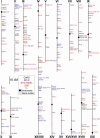Beyond complementation. Map-based cloning in Chlamydomonas reinhardtii
- PMID: 15665247
- PMCID: PMC1065356
- DOI: 10.1104/pp.104.054221
Beyond complementation. Map-based cloning in Chlamydomonas reinhardtii
Abstract
Chlamydomonas reinhardtii is an excellent model system for plant biologists because of its ease of manipulation, facile genetics, and the ability to transform the nuclear, chloroplast, and mitochondrial genomes. Numerous forward genetics studies have been performed in Chlamydomonas, in many cases to elucidate the regulation of photosynthesis. One of the resultant challenges is moving from mutant phenotype to the gene mutation causing that phenotype. To date, complementation has been the primary method for gene cloning, but this is impractical in several situations, for example, when the complemented strain cannot be readily selected or in the case of recessive suppressors that restore photosynthesis. New tools, including a molecular map consisting of 506 markers and an 8X-draft nuclear genome sequence, are now available, making map-based cloning increasingly feasible. Here we discuss advances in map-based cloning developed using the strains mcd4 and mcd5, which carry recessive nuclear suppressors restoring photosynthesis to chloroplast mutants. Tools that have not been previously applied to Chlamydomonas, such as bulked segregant analysis and marker duplexing, are being implemented to increase the speed at which one can go from mutant phenotype to gene. In addition to assessing and applying current resources, we outline anticipated future developments in map-based cloning in the context of the newly extended Chlamydomonas genome initiative.
Figures







Similar articles
-
Nuclear suppressors define three factors that participate in both 5' and 3' end processing of mRNAs in Chlamydomonas chloroplasts.Plant J. 2006 May;46(3):448-61. doi: 10.1111/j.1365-313X.2006.02711.x. Plant J. 2006. PMID: 16623905
-
Molecular map of the Chlamydomonas reinhardtii nuclear genome.Eukaryot Cell. 2003 Apr;2(2):362-79. doi: 10.1128/EC.2.2.362-379.2003. Eukaryot Cell. 2003. PMID: 12684385 Free PMC article.
-
Chlamydomonas reinhardtii as the photosynthetic yeast.Annu Rev Genet. 1995;29:209-30. doi: 10.1146/annurev.ge.29.120195.001233. Annu Rev Genet. 1995. PMID: 8825474 Review.
-
A cosmid vector containing a dominant selectable marker for cloning Chlamydomonas genes by complementation.Plasmid. 2003 Jan;49(1):75-8. doi: 10.1016/s0147-619x(02)00158-0. Plasmid. 2003. PMID: 12584003
-
Arabidopsis map-based cloning in the post-genome era.Plant Physiol. 2002 Jun;129(2):440-50. doi: 10.1104/pp.003533. Plant Physiol. 2002. PMID: 12068090 Free PMC article. Review.
Cited by
-
CDKL5 regulates flagellar length and localizes to the base of the flagella in Chlamydomonas.Mol Biol Cell. 2013 Mar;24(5):588-600. doi: 10.1091/mbc.E12-10-0718. Epub 2013 Jan 2. Mol Biol Cell. 2013. PMID: 23283985 Free PMC article.
-
Retrograde intraflagellar transport mutants identify complex A proteins with multiple genetic interactions in Chlamydomonas reinhardtii.Genetics. 2009 Nov;183(3):885-96. doi: 10.1534/genetics.109.101915. Epub 2009 Aug 31. Genetics. 2009. PMID: 19720863 Free PMC article.
-
Chlamydomonas ODA10 is a conserved axonemal protein that plays a unique role in outer dynein arm assembly.Mol Biol Cell. 2013 Dec;24(23):3689-96. doi: 10.1091/mbc.E13-06-0310. Epub 2013 Oct 2. Mol Biol Cell. 2013. PMID: 24088566 Free PMC article.
-
Phylogenomic analysis of the Chlamydomonas genome unmasks proteins potentially involved in photosynthetic function and regulation.Photosynth Res. 2010 Nov;106(1-2):3-17. doi: 10.1007/s11120-010-9555-7. Epub 2010 May 20. Photosynth Res. 2010. PMID: 20490922 Free PMC article.
-
Spontaneous dominant mutations in chlamydomonas highlight ongoing evolution by gene diversification.Plant Cell. 2015 Apr;27(4):984-1001. doi: 10.1105/tpc.15.00010. Epub 2015 Mar 24. Plant Cell. 2015. PMID: 25804537 Free PMC article.
References
-
- Bennoun P, Béal D (1997) Screening algal mutant colonies with altered thylakoid electrochemical gradient through fluorescence and delayed luminescence digital imaging. Photosynth Res 51: 161–165
-
- Bollenbach TJ, Schuster G, Stern DB (2004) Cooperation of endo- and exoribonucleases in chloroplast mRNA turnover. Prog Nucleic Acid Res Mol Biol 78: 305–337 - PubMed
Publication types
MeSH terms
Substances
LinkOut - more resources
Full Text Sources

